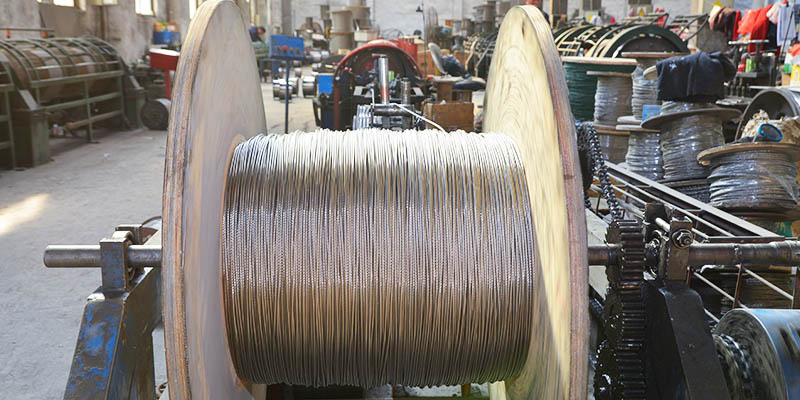1×7 Stainless Steel Wire Rope Product Introduction Overview: The 1×7 stainless steel wire rope is a high-quality, durable, and versatile wire rope constructed from a single strand of seven individual ...
See DetailsOn the vast ocean, the safe navigation and efficient operation of every vessel rely on the coordinated operation of countless precision components. Marine hardware, as key elements connecting, securing, and controlling various ship systems, is often hidden within the hull structure. It serves as the ship's "bones and joints," supporting everything from small yachts to giant cargo ships. Its quality and performance are directly related to a vessel's service life, navigation safety, and even operating costs, making it an indispensable component of marine equipment.
Marine Hardware: Definition and Core Value
Marine hardware broadly refers to various metal products and components used in ship construction, maintenance, and ancillary equipment. It encompasses hundreds of products, from simple bolts and nuts to complex anchoring systems and steering gear accessories. Compared to ordinary industrial hardware, marine hardware faces a more demanding operating environment—constant immersion in salty seawater, enduring the impact of waves, drastic temperature fluctuations, and corrosion from marine organisms. This places far greater demands on material selection, processing technology, and protective properties than is typically required of ordinary hardware.
Within the overall structure of a ship, the core value of marine hardware lies in three key aspects: reliability of structural connections, stability of operating systems, and environmental durability. Whether it's the splicing and fixing of the hull, the installation and positioning of deck equipment, or the connection between the power system and transmission, all require high-precision hardware components. A hardware failure in any link can lead to equipment failure at the very least, or even damage to the hull structure, potentially endangering navigation safety. Therefore, quality control of marine hardware remains a key concern in the shipbuilding and shipping industries.
Hull Structural Hardware: Building a Strong "Steel Skeleton"
As the core structure of a ship, the strength and sealing of the hull directly determine its wind and wave resistance and safety rating. Structural hardware is crucial for ensuring its integrity. This hardware primarily includes rivets, bolts, and nuts used to connect hull plates; hinges and locks used to separate compartments; and profiles such as angles and flat steel used to reinforce the deck.

To withstand the intense corrosiveness of seawater, hull structural hardware is often made of weathering steel, stainless steel, or alloys that have undergone special anti-corrosion treatments. Precision forging and heat treatment techniques are used in the manufacturing process to ensure that the hardware is resistant to deformation or fracture under immense loads. For example, the high-strength bolts used in hull joints require not only precise dimensional accuracy but also rigorous testing for thread strength and fatigue resistance to withstand the constant vibrations caused by the ship's rolling waves.
Navigation and Control Hardware: Controlling the Ship's "Direction and Rhythm"
A ship's navigation and control require a series of precision hardware components. These components act as the ship's "nerves and muscles," translating steering commands into actual navigational maneuvers. This hardware includes rudder hardware, mooring systems, bollards, and fairleads, each of which plays an irreplaceable role in the ship's launch, navigation, and anchoring.
Rudder hardware is the core of a ship's steering, and includes key components such as the rudder shaft, pintle, and rudder bearing. They must withstand significant water resistance while ensuring the flexible rotation of the rudder blades, placing extremely high demands on the material's wear resistance, impact resistance, and sealing properties. Typically, rudder hardware is made of high-strength alloy steel, surface-hardened to enhance wear resistance, and equipped with specialized seals to prevent seawater from seeping in and causing corrosion.
Hardware components in the anchoring system, such as anchor chains, anchor shackles, and swivels, bear the heavy responsibility of stabilizing the ship in designated waters. During anchoring and heaving, these components are repeatedly subjected to complex loads such as tension and torsion, requiring rigorous verification of their strength and toughness. To ensure the reliability of the anchoring system, the relevant hardware is typically forged in one piece to avoid performance risks associated with welding. Regular non-destructive testing is also performed to detect potential cracks or wear.
Protective and Adaptive Hardware: Extending the Service Life of a Ship
The unique characteristics of the marine environment make the protection and adaptation of ship hardware crucial to extending the service life of a ship. Protective hardware primarily includes seals, anti-corrosion coatings, and sacrificial anodes. These components physically or chemically reduce the corrosion of seawater and moisture on a ship's metal structures. For example, gaskets at the joints between the hull and equipment are often made of oil- and seawater-resistant rubber or polytetrafluoroethylene, preventing seawater leakage while also buffering wear caused by equipment vibration.
Adaptive hardware focuses on solving the problem of interoperability between different equipment and structures, such as connectors, flanges, and sleeves of various specifications. These components require high versatility and interchangeability to accommodate potential replacements during ship maintenance. Beyond standardized production, adaptive hardware also requires customization based on the design characteristics of individual vessels to ensure tight and stable connections.
With the rise of green shipping, environmentally friendly protective hardware has become a new industry trend. For example, hardware using a chromium-free passivation treatment ensures corrosion resistance while reducing pollution to the marine environment. High-efficiency sacrificial anodes significantly reduce maintenance costs by sacrificing themselves to protect the ship's metal.
As a fundamental component of the shipbuilding industry, the quality and technical level of marine hardware directly reflect the strength of a country's marine equipment manufacturing industry. From offshore fishing vessels to ocean-going vessels, from luxury yachts to scientific research vessels, the safe voyage of every vessel depends on these silently working hardware components. In the future, with the continued development of the marine economy and advancements in shipping technology, the marine hardware industry will undoubtedly move towards higher performance, greater environmental friendliness, and greater intelligence, providing a more solid foundation for human exploration and utilization of the ocean.
